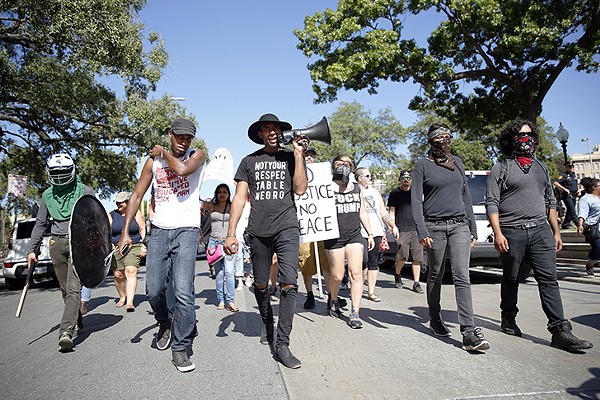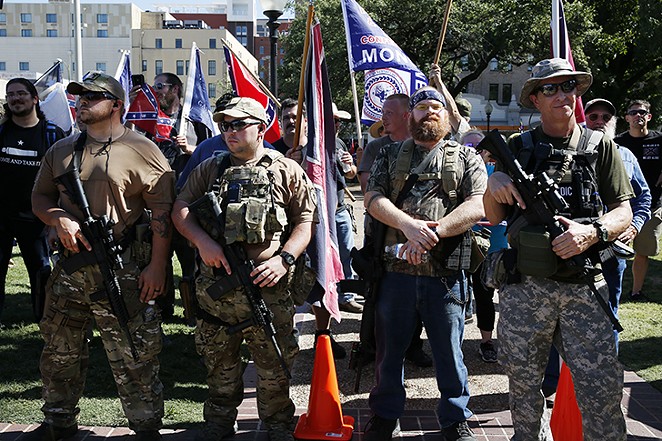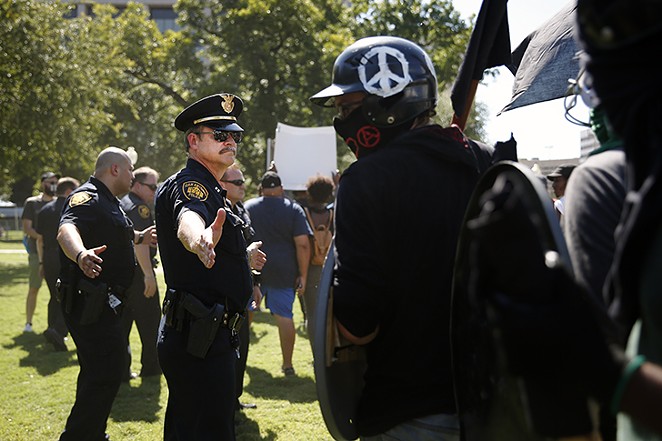San Antonio: A Tale of Two Cities
Jordan Maney is a San Antonio event planner focused on representation of people of color and the queer community in the wedding industry. She spent Saturday at the contentious Travis Park protest over the removal of a Confederate memorial. This is what she saw.
“This is Texas!”
I heard that sentiment echoed multiple times over megaphones, shouts, and chants Saturday afternoon. Watching the faces of white supremacists aglow from the flame of torches on the University of Virginia’s campus Friday evening, I knew I’d have to go to San Antonio’s “No Hate, No Fear” counter protest on Saturday. If something even close to that happened here I wanted to see it with my two eyes. Before I even crossed the street to get to Travis Park I spotted 11 Confederate flags. The Confederate crowd was largely monochromatic with the exception of one black man screaming about heritage. Oh boy.
Several park enthusiasts ended up leaving when they saw the flags. Some people still walked their dogs and sat at the picnic tables between our barricades to observe. Behind the counter protest barricade stood people of different generations, abilities, sizes, sexual orientations, colors, faiths, and gender identities, myself included. In a living metaphor for the current state of the world, the three groups — the ones holding onto the past, the ones pushing for the future, and the ones presently observing — filled the park.
With one declared dead in Charlottesville just hours before our rally, I was prepared for anything. I looked at the buildings behind us. Would this be Dallas? I watched the motorcycles draped in Confederate regalia drive around the perimeter of the park. Would this be Charlottesville? I saw two grown male police officers force a lanky kid down to the ground, sit on his neck and back to arrest him for simply moving his shoulder when another officer tried to touch him. Would this be Ferguson?
Things grew more tense with stragglers from the Confederate side wandering over to the other barricade. One tried to give us the peace sign and wave a mini rebel flag simultaneously. My head hurt just looking at him. Another pair of men donning baseball caps and Oakley shades tried to come behind the barricades multiple times. They took pictures of us surely as we took pictures of them. This happened more than a handful of times. A pair of twins I nicknamed “the Whining” used the same tactic. My brain went into overdrive worrying about what they’d do with our pictures but I let it go. I’d already made my peace with dying before I got to the park. If that seems a touch melodramatic I’d point to the melodrama that’s been ratcheting up in our country for the past three years. Unpredictable has become the predictable.
SAPD had someone not so discreetly videotape us as well. Almost on cue I waved and posed. I didn’t have a mask on so I’m sure it took no time for them to identify me. At one point another bearded, Oakley sunglasses clad, plaid button down shirt wearing (is this the official uniform or something?) man wandered over to get us on livefeed. We told him he had to go while we were made out to be racists. “Are you saying I can’t be here because I’m white?!,” he said indignantly. I was flanked by two white women. Guess he didn’t see color. If we were to leave the side of our barricade we were promptly told to get back with bikes or forceful hands. It was like symbolism heaven. Minority groups relegated to one section, furrowed brow white men allowed undisturbed access then infuriated when someone dare tell them to go elsewhere. For some reason not as much attention was paid to gun-toting loyalists of an anti-Union organization. Funny how that works.
At one point Mike Lowe, the head organizer for the “No Fear, No Hate” rally called on those gathered to stage a die in. We laid on the hot pavement while a speaker read the “Declaration of Causes” a document that declared Texas’ secession from the Union. The concrete was searing hot and many of us moved around to find some kind of comfort. We found none. As we were lying down looking up at the sky, trying to cover our faces from the glare of the sun, the speaker read the words of Confederates loud enough for their descendants to hear. Then the sound came. It was a crescendo of jeers and shouts, exclamations and hoots. If staging death was such a thrill for them would our actual deaths just be sport?
Staring at the limbs of a tree waving above us, I imagined if that sound was what a victim heard before a lynch mob arrived. Maybe it did feel like a sport to hunt someone down, rip them from their home, tie a noose around their neck, wait for the confirming snap, cut off toes and fingers as mementos, mutilate their genitals, and torch the body all before breaking out the picnic baskets. In a state that was third in number of lynchings, I thought about how many of their ancestors would be pleased with their display today. How many of mine would still be terrified? The numbers 1861 may have changed to 2017 but white supremacy and the attitudes that perpetuate it are ageless. I may have rights (the first generation born with them fully with parents born before the Voting Rights Act), but it’s conditional. In a country based on an ideology that didn’t include all of us because all of us weren’t considered equal, yet alone human, we fight to be placed in a narrative that would rather forget its hand than confront its reflection.
Separated by the barricades but flanked by police, the image of SAPD officers donning Make America Great caps flashed before me. How many of them voted for a President that not only endorsed the kind of hate speech I was hearing over the megaphone but would be on the other side if they were off duty? How many Confederate flag wielding protesters on the other side of the park (and the wrong side of history) were teachers, loan officers, business owners, bankers, public servants, first responders, pastors, and neighbors? Ironically, nothing is ever as black and white as we think it to be. But on Saturday in Travis Park, San Antonio had to reconcile two things: who it’s been and who it’ll be.
My father distinctly remembers having to go through the “Colored” entrance in the back of the Majestic, my mother is only a year younger than Ruby Bridges. Erasing that reality only benefits the very descendants of those who enacted and enforced those restrictions. San Antonio has yet to look itself in the mirror. We can say this isn’t who we are but it’s who we’ve been. Resistance to that acknowledgement only allows it to live on longer. Tearing down a statue that black and brown children have played in the shadow of is necessary. Relegate those figures to where they need to stay — the past. There’s no room for them now. What we’re witnessing in Charlottesville, in Texas, and across the country is a collective temper tantrum by people who misunderstand their place in history.
There is no pride in hate, there is no heritage in dishonor. They were rebels with the wrong cause who bled, fought, and died for nothing. We don’t need to honor their sacrifice to a cause that kept millions in chains. It wasn’t about protecting the Texas plains or Louisiana bayous or Georgia hills. It was about using the lives of poor whites to protect the comfort of wealthy whites who depended on the labor of enslaved blacks. That’s it. It was no more about states’ rights than this election was about economic anxiety. It was about preserving comfort. The same as the rally that brought people from out of town to “protect” a statue that stood proudly for 118 years. That legacy doesn’t need protecting, it needs correcting.
It is a sentiment echoed in conversations I’ve had with transplants and natives alike. There is a resistance to changing the status quo here. There is a resistance to speaking up when it’s much more convenient to just be quiet. There is a pride in ignoring the problem and its symptoms for Osteenian rhetoric that changes nothing. Our city, by design, is one of the most economically segregated in the country. We have the largest MLK March in the country yet are mum about actions organized to bring awareness to the very thing Martin Luther King Jr. lived and died for. People convince themselves that they would have marched with him then but sit at home now wondering why so many people feel compelled to be “disruptive.” They shake their head at Ferguson because they need the facts but remain silent about Charlottesville. They convince themselves that nothing like that could happen here. But it can happen anywhere white supremacy and white supremacists are tolerated and even encouraged. That kind of thinking will have marchers descend onto campuses with torches, it will empower lunatics to drive their vehicles into bodies, it can even inspire people to ascend to the highest office of our country when people are too afraid to acknowledge it. Is San Antonio a city afraid of change? Convincing ourselves that we don’t have those problems here is a rallying cry before dipping our heads even further into the sand. The answer to what will Texas and what will our city be remains squarely on our shoulders.
The form of protest doesn’t matter, a march, a rally, a knee — the form isn’t the problem, the protest is. When I hear people complain that our generation is simply too violent, I remember John Lewis barely stepped foot off the Freedom Riders bus before being clubbed over the head with a bat. When I hear people complain about our choice of clothes I remember that suits didn’t keep Medgar Evers and Martin Luther King, Jr. from being assassinated. When I hear people complain about this not being the time or the place for such discussions, I remember that Civil Rights activists were beaten for simply sitting at lunch counters. When I hear people tell me prayer is the only thing that will change laws, I’m reminded of the black churches bombed by white church-goers themselves. If this isn’t the time and this isn’t the place, when and where is? Sometime in the future where you won’t be alive? No. The time is now. The statue had over 100 years to stand. It’s time to come down.
This isn’t erasure of history. Erasure is telling current and future generations that slaves were simply helpers. Erasure is choosing to forget that “For Whites Only” signs hung in this city. Erasure is telling teachers to tone it down when teaching a narrative steeped in blood and hate. Moving a statue to a place where people can still view it, learn about it, take pictures of it, and interact with it isn’t erasure. It’s proper placement. To build a San Antonio that benefits everyone we need to acknowledge our history and reconcile it. For us to move forward, these monuments need to be moved out of the way.
Texas was a part of the Confederacy. What it is now and what it will be depends on us. The narrative Texans write is no longer dependent on one hand. The pen belongs to black, brown, Muslim, and queer Texans alike. It belongs to all of us.





